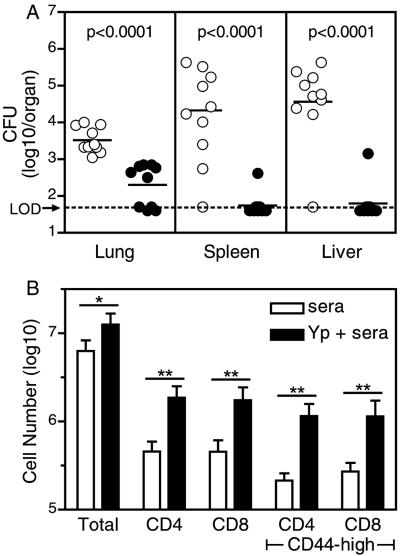FIG. 4.
Vaccination-mediated protection of μMT mice against intranasal Y. pestis challenge correlates with reduced bacterial growth and dissemination and increased numbers of pulmonary T cells. B-cell-deficient μMT mice were vaccinated with live Y. pestis (2 × 105 CFU Y. pestis KIM D27 [Yp], intranasally) in combination with serotherapy. Control mice received serotherapy alone. Sixty days later, both vaccinated and control mice were intranasally challenged with 2 × 105 CFU Y. pestis KIM D27 as described for Fig. 3. At 72 h postchallenge, mice were euthanized and tissues harvested. (A) Numbers of bacteria were significantly reduced in pulmonary, splenic, and hepatic tissues of vaccinated (closed symbols) compared with control (open symbols) mice (n = 10 per group; P < 0.0001 for all tissues). Data are pooled from two independent experiments. Horizontal bars depict median values; LOD, limit of detection. (B) Numbers of total leukocytes, CD4-positive cells, CD8-positive cells, activated (CD44-high) CD4 cells, and activated CD8 cells in lung tissues of vaccinated (solid bars) compared with control (open bars) mice (n = 5 per group; *, P < 0.005; **, P < 0.0005). Data are representative of results obtained in two independent experiments. Error bars indicate standard deviations.

